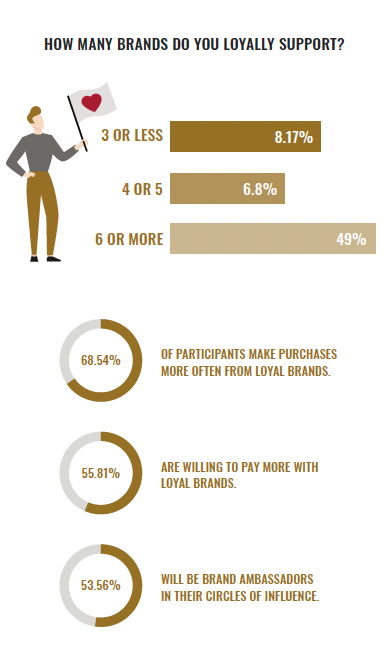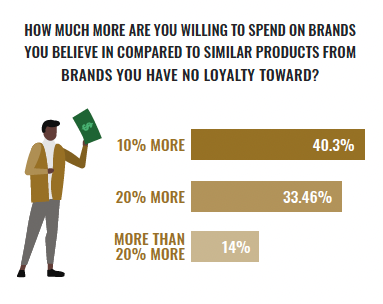February 17, 2022
What is the Real Value in Cultivating Brand Loyalty?
David Brashears

Building compelling brand strategies that engage and create sustainable brand loyalty is not a small, nor an inexpensive, task. It requires a top-down evaluation of a company’s internal belief system and mission for their own workers, partners, and end-users. It requires an honest perspective on what their brand value and brand promise will be to all levels of their organization. There needs to be buy-in at the executive level about real values that are relevant to their target market audience, or it cannot be sustainable. Taking a position in order to elicit a short-term publicity recognition will quickly be uncovered by consumers and employees that can sabotage positions that are not practiced in all areas of a brand.
If a brand is going to undertake the task of building a cult brand position, it needs to have some measurable data that there is a return on investment that makes the work worthwhile. We’ve believed in the value of brand culture development for decades, and have seen that the industry has consistently confirmed our beliefs in buying behavior, and how it is tied to culture.
In 2020, Patricia Rioux wrote an article for Forbes entitled “The Value of Investing in Loyal Customers.” It’s a great article that gives some unbiased validation to how the modern buyer is engaging with brands and choosing to invest in companies they believe in. In her article, there seem to be four areas of valuation that a brand should consider when developing a brand culture strategy that can pay off with valuable and long-lasting dividends.

CUSTOMER CONVERSION
In a study, Marketing Metrics, the probability of selling to an existing customer is up to 14 times higher than selling to a new customer.
CUSTOMER RETENTION
Bain & Company and Harvard Business School reported that increasing customer retention rates by only 5% can increase profits by 25% to 95%.
PRODUCT PURCHASE EXPANSION
An article by Jessica Huhn of Business 2 Community found that existing customers are 50% more likely to try new products and spend 31% more, on average, compared to new customers.
COST OF ACQUISITION
A report by Hubspot found that new customer acquisition costs have increased by almost 50% in just the past five years.
Understanding the Value of a Loyal Brand Believer is Critical to Creating a Value Position That Gets Real Results
In the independent research we did for our own Cult Brand case study, we saw similar insights in our survey when asking participants to share their own experiences with brands and what brand culture means to them. 81.58% of respondents agreed that company culture directly impacted brand loyalty in their buying decisions. Interestingly, in our client survey, only 57% of company respondents agreed with this statement.
We also found that buying behavior was drastically influenced by brand culture and loyalty as well. Here’s a graphic that summarizes our findings:

As mentioned above, one of the more powerful tools to grow business and profitability is through improving customer retention. Not only are these brand supporters more open to being marketed to by the brands they believe in, it is also drastically cheaper to influence their purchase decisions and promote new products to these customers than cultivating new ones. The best way to retain loyal brand customers is through building brand value and a brand promise that is relevant, relatable, and gives target customers an invitation to collaborate with the company. Creating brand ambassadors by providing well-developed content through blogs, social media, and video storytelling is a powerful way to inspire loyalty and advocacy by your brand followers.
Another powerful benefit of investing in building your brand equity with customers is stabilizing market loss through disruptions in performance. In short, sometimes we all screw up, even global companies can have moments where product quality, service, or publicity can fall short of their standards. If this is systemic, then it can be the death knell to trying to develop real brand culture, so that’s got to be addressed immediately. However, these issues are more often related to momentary issues within the manufacturing process or a complicated service problem that results in an unsatisfied customer.
The good news is that, if you have created a brand culture around your business and are quick to resolve the issue in accordance with your brand culture promises, you are far less likely to lose that customer than if you hadn’t properly engaged with them on a deeper level. In our survey, we asked participants how likely they were to use a product or service from a brand they believe in again after a poor experience as compared to a poor experience with a brand they had no attachment to. Participants were four times more likely to continue to support loyal brands that had an issue as compared to non-engaged brands.

There is also the consideration that one of the most powerful and effective sales and marketing strategies since the dawn of modern business is tied directly to your ability to create an effective brand culture—the dynamic and compelling influence of word-of-mouth. Word-of-mouth marketing is still the holy grail of creating real momentum for your brand and market share. The power of inspiring an audience to talk about your brand with those they interact with or wear merchandise proudly that promotes your brand is incredibly important to aggressive growth. Are modern shoppers, who are inundated with advertisements and marketing messages, still willing to promote brands with their friends and family? Here are some of the answers we received that confirm they absolutely are.
Loyal brand supporters are also much less prone to being impacted by “retail path manipulation” that may give retailers (both online and physical) more power over brand decisions than you’d prefer. Endcap displays, digital advertising, and shopping algorithm targeting can require constant spending in order to earn prime location for your products. However, if you’ve invested in an effective brand culture position campaign, your loyal brand customers are much less likely to be influenced to purchase from your competitors based on retail merchandising. You retain much more control over your own purchase path by engaging with your customers directly and encouraging buy-in.

If, however, you set aside a percentage of your content to relevant social and global issues that align with your brand position and promise, then you can greatly improve the engagement and dissemination of those stories that will still direct new audiences back to your brand. Also, let’s be honest, most social media professionals would still give just about anything to report content engagement and sharing at a rate of 22.4%. That’s still a huge win compared to more traditional brand strategies.
THE FACT OF THE MATTER IS THAT CULTIVATING BRAND LOYALTY IS CRITICAL TO BUILDING A MARKET STRATEGY THAT WILL ENDURE IN THE LONG TERM.
Customers want to believe that the way they choose to spend their hard-earned money matters beyond an exchange for goods and services. It’s at the very center of why we develop brands around our products and services in the first place. Companies want to be proud to have their brand names well respected in the marketplace and have their customers celebrate the work the brand is doing.
Building brand culture requires discipline, foresight, and regular interaction with your customers. Having an agency partner that not only understands the process of creating brand culture is crucial to getting it right and making the most of every market opportunity.
CREATIVE ENERGY HAS BEEN PROMOTING THE VALUE IN BRAND LOYALTY AND BRAND CULTURE FOR NEARLY 30 YEARS.
We know not only how valuable strategic brand positioning can be for your business, but what the process is to help you develop it properly from the very beginning. There are certain things that need to be understood about modern shoppers that must be taken into consideration when building a vision for your brand. So, if you’re ready to start building a brand belief system that engages and empowers your most loyal customers, let’s talk today.
Get insights delivered straight to your inbox.